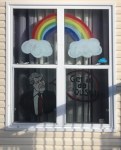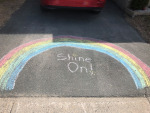COVID-19: The Ambiguous Image
[image error]
I was very young, probably in early elementary school, the first time someone showed me the image above and asked “What do you see?”
I saw two people looking at each other, of course, because what else would you see? Until someone pointed out there was a vase there as well, and after that, I couldn’t un-see the vase.
There are many such ambiguous images, and it’s always interesting to me how our mind grasps on to one picture first, and then, once we’ve seen the second, seems to shift back and forth between the two. Then of course in 2015, the entire internet learned the same phenomenon works not just with shapes but with colours, as we collectively lost our minds over a photo of an obviously white-and-gold dress (spoiler, in case you slept through 2015: the dress was blue and black).
Lately it feels to me like the COVID-19 pandemic, as I’m experiencing it both in real life and on social media, is a bit like The Dress, or Rubin’s Vase, or any other ambiguous image. Either way, of course, it’s an undeniable tragedy, with over 250,000 people confirmed dead worldwide (as I write this on May 5), millions of jobs lost and lives uprooted. There’s no positive spin to this virus. And yet, when I look at it one way, I can only see:
incompetent politicians making bad decisions
angry people showing up with guns and without masks to crowded protests
poverty, hunger, depression, domestic violence all on the rise
people being rude and even violent to essential workers
frightened, desperate people unsure how things will ever get back to “normal”
dumb, arrogant people blatantly disobeying sensible public health orders
judgy, self-righteous people criticizing others for disobeying public health orders
everyone being angry, sad, indignant, outraged, despairing at a problem for which there’s no end in sight.
All of that is true. All of that is really happening. It’s as real as the two faces staring at each other, implacable and opposed and identical.
But if I stare at the picture I’m living in just a little longer, I see the vase, and what it’s holding. I see:
health care workers risking their own lives daily to care for others
minimum-wage frontline workers continuing to serve with warmth and kindness despite the risks they face
teachers finding creative ways to connect with students from home
community groups putting together innovative solutions to reach out to people struggling with hunger, homelessness, mental illness, and domestic violence
governments and public-health experts doing their best to lead through a crisis where the information is constantly changing
doctors becoming unexpected social-media stars just for telling us what we should and shouldn’t do
people reaching out to their neighbours with acts of kindness and generosity
senior citizens learning to use Zoom to connect with friends and family
churches developing new tools for worship so people can continue to feel connected to their community
rainbows, hearts, and messages of hope painted and pinned in people’s windows to keep us all filled with encouragement


I’m not saying the things on the second list are an “upside” or that we just need to “look on the bright side.” There is no “bright side” to a global pandemic that’s killing hundreds of thousands of people.
But there are two ways to look at our human responses to this pandemic, because the human responses run the gamut from the literally sublime to the literally ridiculous. Just like the ambiguous pictures, both extremes of the response are real, and are actually happening all around us. But when all I can see is the negative response, I have to remember to shift my perspective sometimes and see a different picture. Shifting that focus helps me remember that, in the immortal words of one local encouraging sign-painter:
[image error]
Graffiti on Duckworth St., St. John’s. Photo credit: Dave Sullivan. Artist: Unknown.



